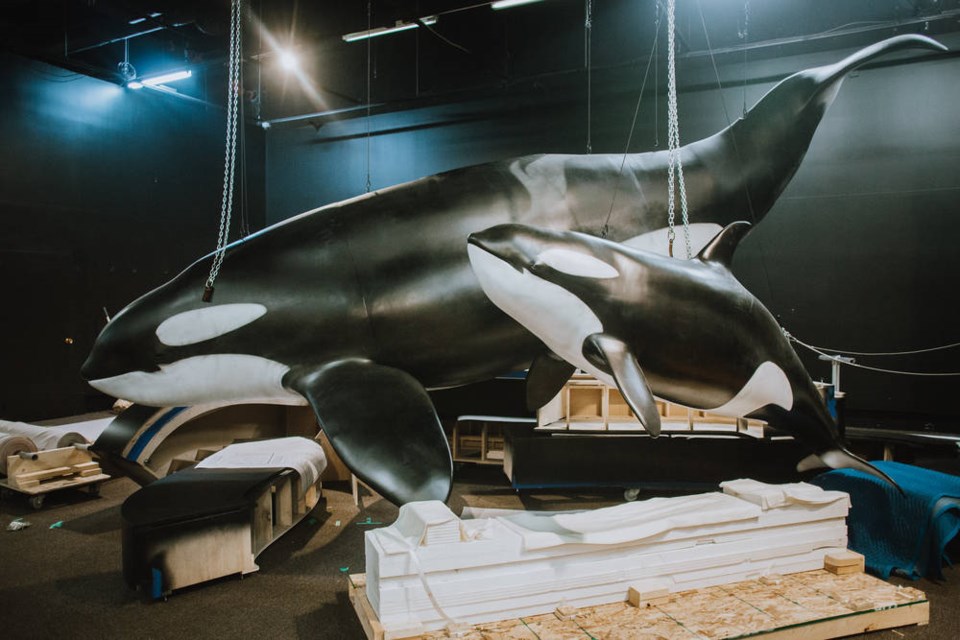He was known as Ruffles and numbered J1.
The big male orca, named for his tall jagged dorsal fin, was one of the first southern resident killer whales identified by scientists in J-Pod in the 1970s.
The nine-metre J1 lived a full life, fathering at least 16 calves in all three southern resident pods — J, K and L. Twelve of them are still alive and his legacy continues with 12 grandchildren and one great-grandchild.
Ruffles was estimated to be 60 when he disappeared in 2010 and was presumed dead.
But the mighty orca lives on.
He’s one of three life-size replicas going on display at the Royal British Columbia Museum’s feature exhibition Orcas: Our Shared Future, which opens April 16 and runs to January 2022.
The event was cancelled last year due to pandemic restrictions, but is back on track during a critical time for the beloved but struggling marine mammals.
Southern resident orcas now number 75 after three births over the past six months, but their struggle for food, chiefly chinook salmon, continues.
Gavin Hanke, curator for vertebrate zoology at the Royal B.C. Museum and one of the chief scientists behind the exhibit, said people have developed a kinship with the resident orcas, as the various family groups navigate an increasingly complex world of food supply, pollution, toxins and marine traffic that interfere with communication in their traditional areas.
“People love wolves and grizzly bears, too, and the Biggs [transient] orcas, but they are not coded, named and recognized as individuals,” Hanke said. “The residents are like people. They have names, families, history and that’s what’s so great to see. These are highly intelligent animals and we should appreciate them.”
The three replica orcas also include Slick, or J16, at 49 the oldest female in J-Pod who is still swimming the Salish Sea, and her daughter, Scarlett, or J-50.
Scarlett, who died in 2018, made international headlines when the three-year-old was discovered severely underweight. Scientists from Canada and the U.S. tried to feed her salmon and administered antibiotic darts, attempting a capture to provide medical assistance.
Hanke said the replica models were created using years of photographs and measurements taken from drone video.
The exhibit also contains the skeletal remains of J-32, or Rhapsody, an 18-year-old pregnant juvenile found dead near Comox in 2014.
Necropsy results indicated Rhapsody died from an infection linked to her near-term fetus.
Her body was filled with toxic contaminants often found stored in orcas’ and whales’ blubber, said Hanke.
“The organs, blubber and muscle had to be disposed of in the landfill, in the toxic-waste section, because of the contaminants in her body,” said Hanke.
Rhapsody’s story and skeletal remains — as well as those of her fetus — will be a centrepiece of the museum’s display and bring attention to the plight of the southern residents, said Hanke.
“Her story personally changed me,” said Hanke. “She was eating salmon for 18 years with toxic waste. I gave up fishing, try to grow most of my own food. We drive an electric car now.”
Fewer boats on the water during the pandemic have likely helped the orcas, improving echolocation techniques in finding food.
For orcas, heavy boat and freighter traffic is like “being in a pub that’s super noisy. You almost have to yell to be heard,” said Hanke.
He said many whale-watching companies are being responsible and keeping their distance. There are also boaters who are converting to electric motors, and whale-watching land observation posts are being developed.
“A partner in the exhibition, Eagle Wing Tours, often takes people out to view the transient orcas, as opposed to the southern residents,” said Hanke.
The museum’s exhibition is taking a deep dive into the stories and science that surround the apex predator of the oceans.
Visitors can explore ecological activism, popular culture and Indigenous beliefs to gain a deeper understanding of how orcas and humans are inextricably connected.
“This is a timely and challenging story — and one that we are uniquely qualified to tell,” said museum board chair and acting CEO Dr. Daniel Muzyka in a statement. “Our unique collections, curatorial expertise, and physical and emotional proximity to orcas and oceans combine in an edifying and ultimately hopeful experience that affirms we are all part of nature — not apart from nature.”
Among the artifacts on display are rare cultural objects by Indigenous artists, including an articulated dance mask by Richard Hunt (Kwaguilth), an intricately carved gold killer whale box by Bill Reid (Haida), and a commissioned painting by Haida manga artist Michael Nicoll Yahgulanaas.
The exhibition includes a companion publication that brings together the work of marine biologists, Indigenous knowledge keepers, poets, artists and storytellers. Spirits of the Coast: Orcas in Science, Art and History is edited by Hanke, Martha Black and Lorne Hammond and available at local bookshops, the Royal Museum Shop and online at rbcm.ca/books.
The exhibition has been designed to travel to other museums during the UNESCO Decade of Ocean Science for Sustainable Development (2021-2030)
The museum is following pandemic safety protocols. To purchase timed tickets, visit rbcm.ca/orcas.
Note to readers: This story has been updated. An earlier version identified Rhapsody as J-52. She is J-32.



